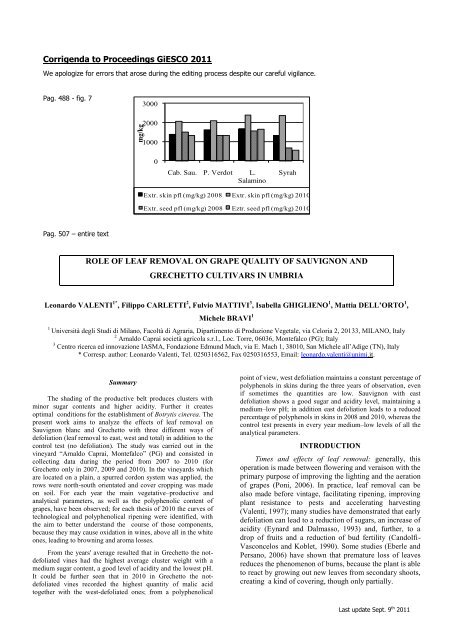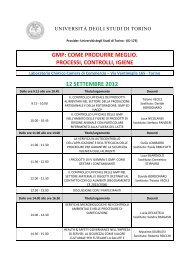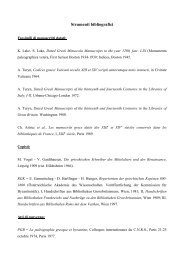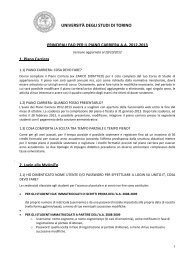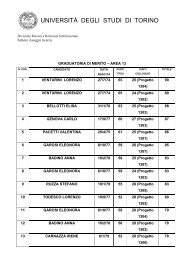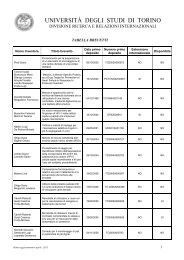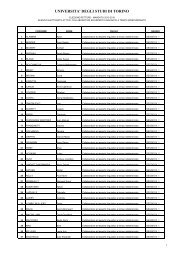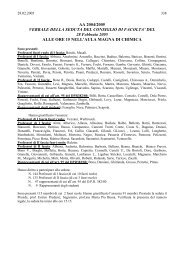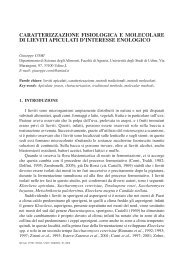17th International Symposium GiESCO 2011 - Università degli Studi ...
17th International Symposium GiESCO 2011 - Università degli Studi ...
17th International Symposium GiESCO 2011 - Università degli Studi ...
Create successful ePaper yourself
Turn your PDF publications into a flip-book with our unique Google optimized e-Paper software.
Corrigenda to Proceedings <strong>GiESCO</strong> <strong>2011</strong><br />
We apologize for errors that arose during the editing process despite our careful vigilance.<br />
Pag. 488 - fig. 7<br />
Pag. 507 – entire text<br />
ROLE OF LEAF REMOVAL ON GRAPE QUALITY OF SAUVIGNON AND<br />
GRECHETTO CULTIVARS IN UMBRIA<br />
Leonardo VALENTI 1* , Filippo CARLETTI 2 , Fulvio MATTIVI 3 , Isabella GHIGLIENO 1 , Mattia DELL’ORTO 1 ,<br />
Michele BRAVI 1<br />
1 <strong>Università</strong> <strong>degli</strong> <strong>Studi</strong> di Milano, Facoltà di Agraria, Dipartimento di Produzione Vegetale, via Celoria 2, 20133, MILANO, Italy<br />
2 Arnaldo Caprai società agricola s.r.l., Loc. Torre, 06036, Montefalco (PG); Italy<br />
3 Centro ricerca ed innovazione IASMA, Fondazione Edmund Mach, via E. Mach 1, 38010, San Michele all’Adige (TN), Italy<br />
* Corresp. author: Leonardo Valenti, Tel. 0250316562, Fax 0250316553, Email: leonardo.valenti@unimi.it.<br />
Summary<br />
The shading of the productive belt produces clusters with<br />
minor sugar contents and higher acidity. Further it creates<br />
optimal conditions for the establishment of Botrytis cinerea. The<br />
present work aims to analyze the effects of leaf removal on<br />
Sauvignon blanc and Grechetto with three different ways of<br />
defoliation (leaf removal to east, west and total) in addition to the<br />
control test (no defoliation). The study was carried out in the<br />
vineyard “Arnaldo Caprai, Montefalco” (PG) and consisted in<br />
collecting data during the period from 2007 to 2010 (for<br />
Grechetto only in 2007, 2009 and 2010). In the vineyards which<br />
are located on a plain, a spurred cordon system was applied, the<br />
rows were north-south orientated and cover cropping was made<br />
on soil. For each year the main vegetative–productive and<br />
analytical parameters, as well as the polyphenolic content of<br />
grapes, have been observed; for each thesis of 2010 the curves of<br />
technological and polyphenolical ripening were identified, with<br />
the aim to better understand the course of those components,<br />
because they may cause oxidation in wines, above all in the white<br />
ones, leading to browning and aroma losses.<br />
From the years' average resulted that in Grechetto the not-<br />
defoliated vines had the highest average cluster weight with a<br />
medium sugar content, a good level of acidity and the lowest pH.<br />
It could be further seen that in 2010 in Grechetto the notdefoliated<br />
vines recorded the highest quantity of malic acid<br />
together with the west-defoliated ones; from a polyphenolical<br />
mg/kg<br />
3000<br />
2000<br />
1000<br />
0<br />
Cab. Sau. P. Verdot L.<br />
Salamino<br />
Syrah<br />
Extr. skin pfl (mg/kg) 2008 Extr. skin pfl (mg/kg) 2010<br />
Extr. seed pfl (mg/kg) 2008 Eztr. seed pfl (mg/kg) 2010<br />
point of view, west defoliation maintains a constant percentage of<br />
polyphenols in skins during the three years of observation, even<br />
if sometimes the quantities are low. Sauvignon with east<br />
defoliation shows a good sugar and acidity level, maintaining a<br />
medium–low pH; in addition east defoliation leads to a reduced<br />
percentage of polyphenols in skins in 2008 and 2010, whereas the<br />
control test presents in every year medium–low levels of all the<br />
analytical parameters.<br />
INTRODUCTION<br />
Times and effects of leaf removal: generally, this<br />
operation is made between flowering and veraison with the<br />
primary purpose of improving the lighting and the aeration<br />
of grapes (Poni, 2006). In practice, leaf removal can be<br />
also made before vintage, facilitating ripening, improving<br />
plant resistance to pests and accelerating harvesting<br />
(Valenti, 1997); many studies have demonstrated that early<br />
defoliation can lead to a reduction of sugars, an increase of<br />
acidity (Eynard and Dalmasso, 1993) and, further, to a<br />
drop of fruits and a reduction of bud fertility (Candolfi-<br />
Vasconcelos and Koblet, 1990). Some studies (Eberle and<br />
Persano, 2006) have shown that premature loss of leaves<br />
reduces the phenomenon of burns, because the plant is able<br />
to react by growing out new leaves from secondary shoots,<br />
creating a kind of covering, though only partially.<br />
Last update Sept. 9 th <strong>2011</strong>


